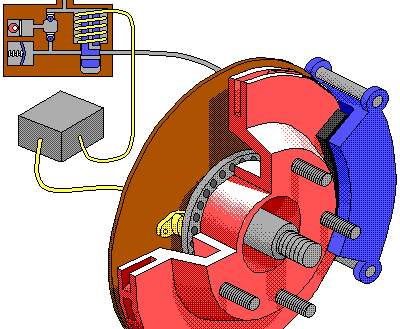| Anti-Lock Braking System |
 |
 |

Below is an explanation of this system's operation:
Anti-lock Brake Systems (ABS)
Originally developed for aircraft, ABS basically works by limiting the pressure to any wheel which
decelerates too rapidly. This allows maximum stopping force to be applied without brake lockup (skidding).
If standard brakes are applied too hard, the wheels "lock" or skid, which
prevents them from giving directional control. If directional control (steering)
is lost, the vehicle skids in a straight line wherever it is going. ABS
allows the driver to steer during hard braking, which allows you to control
the car much better. In the old days, drivers had to know how to "pump"
the brakes or sense the lockup and release foot pressure in order to prevent
skidding. This meant that if only one wheel lost traction and started to
skid, the driver would have to reduce braking force to prevent a skid.
The advantage of ABS is that the brakes on the wheels with good traction
can be used to the fullest possible amount, even if other wheels lose traction.
In operation, the wheelspeed sensors at each wheel send
electronic pulse signals to the control unit. If wheel lockup (rapid deceleration)
is detected during brake application, the computer signals the valve unit
to limit the hydraulic pressure to the wheel cylinder. This is usually
accomplished by diverting the fluid into a small reservoir. The fluid is
later pumped out of the reservoir and returned to the main fluid reservoir
when the brakes are not being applied.
The anti-lock brake system tests itself every time the
vehicle is started and every time the brakes are applied. The system evaluates
its own signals. If a defect is detected, the system then turns off, leaving
normal braking unaffected.
| Sponsor Links |
 |
 |
|